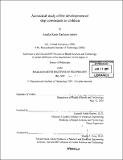Acoustical study of the development of stop consonants in children
Author(s)
Imbrie, Annika Karin Karlsson
DownloadFull printable version (8.054Mb)
Other Contributors
Harvard University--MIT Division of Health Sciences and Technology.
Advisor
Kenneth Noble Stevens.
Terms of use
Metadata
Show full item recordAbstract
This study focuses on the acoustic patterns of stop consonants and adjacent vowels as they develop in young children (ages 2;6-3;3) over a six month period. Speech is generated using a series of articulatory, laryngeal, and respiratory gestures that children must learn to reproduce. As a child's speech develops, the gestures become more precise and coordinated, and the resulting acoustic patterns are refined. To explore their development, over forty different acoustic measurements were made on each of 1049 recorded utterances from ten children, including durational, amplitude, spectral, formant, and harmonic measurements. These acoustic data are interpreted in terms of the supraglottal, laryngeal, and respiratory actions that give rise to them. Data show that some details of the child's gestures are still far from achieving the adult pattern. Children have acquired appropriate positioning of their primary articulator for producing a stop consonant, but are still learning to adjust the tongue body during the consonant production. At constriction release, children have a high incidence of multiple bursts and a short burst duration, interpreted as a reflection of increased articulator compliance, smaller articulator size, and high subglottal pressure. Children are also still acquiring correct adjustment of vocal fold stiffness and glottal spreading as well as intraoral pressure, as evidenced by long voice onset times and highly variable fundamental frequencies. Additionally, amplitude changes over the course of the utterance and high amplitude variability reveal that children have not yet gained full control over subglottal pressure. (cont.) Overall, results indicate that children are less consistent than adults in controlling and coordinating various gestures and with finding the ideal respiration and vocal tract postures, including the stiffness of their articulators. Certain aspects of child speech are found to become more similar to adult values over the six month period of the study.
Description
Thesis (Ph. D.)--Harvard-MIT Division of Health Sciences and Technology, 2005. Includes bibliographical references (p. 142-146).
Date issued
2005Department
Harvard University--MIT Division of Health Sciences and TechnologyPublisher
Massachusetts Institute of Technology
Keywords
Harvard University--MIT Division of Health Sciences and Technology.